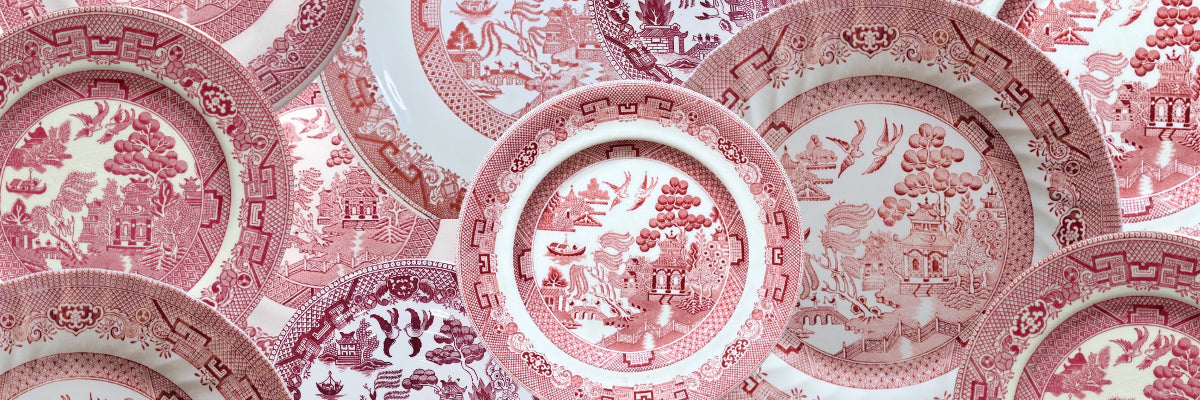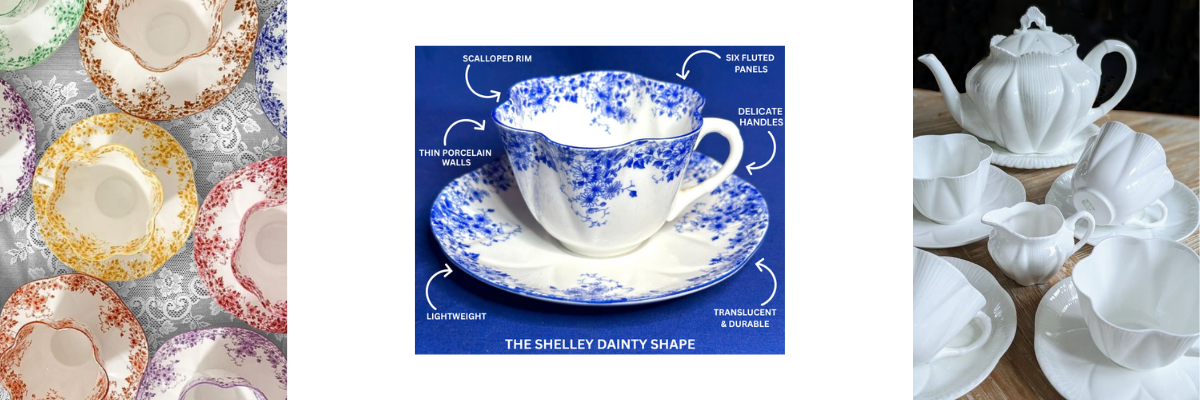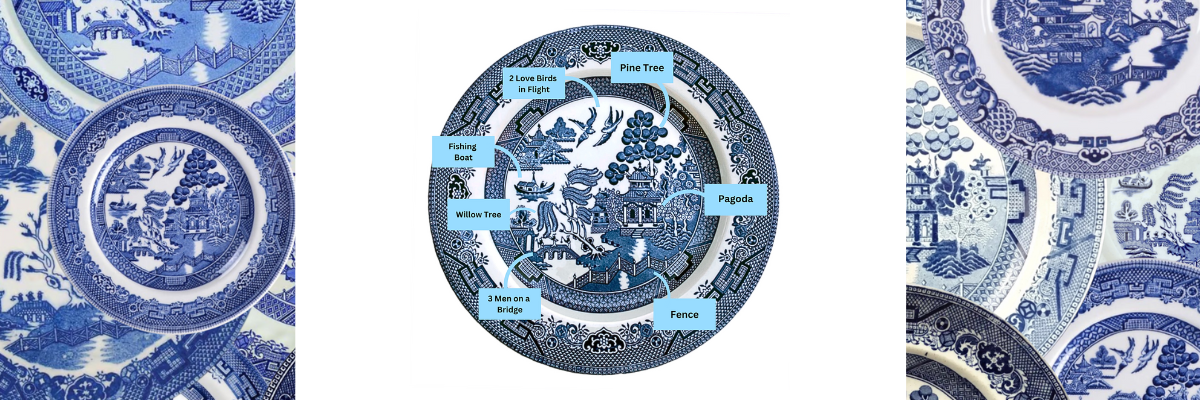Red Willow China: A Classic Pattern Reimagined
The Red Willow china pattern offers a distinctive alternative to the beloved Blue Willow china pattern. Emerging after the success of Blue Willow in 18th-century England, this red variation maintains all the classic storytelling elements—the pagodas, bridges, and legendary lovers—while giving collectors and design enthusiasts an option beyond the traditional blue and white aesthetic. Red Willow preserves the same intricate details and narrative, celebrating the fusion of Eastern inspiration and Western craftsmanship through the same transferware technology that made the original pattern accessible.

What is Red Willow China?
The Red Willow china pattern features the same distinctive design as its Blue Willow predecessor but replaces the traditional cobalt blue with red tones on white porcelain. Like its blue counterpart, Red Willow was created through a transfer-printing process on pottery (known as Transferware), which allowed for detailed designs to be mass-produced more efficiently than hand-painting. When manufacturers began producing the Red Willow variation, they maintained this innovation that made decorative tableware more affordable and accessible to middle-class households, but offered a different colorway that provided an alternative to the classic blue and white aesthetic.
While Blue Willow has always been the most popular color variation, Red Willow emerged as one of several color alternatives that manufacturers developed to diversify their offerings. Other varieties beyond the original Blue Willow include Green Willow, Pink Willow, Black Willow, and Brown Willow—each offering its own distinctive interpretation of the classic pattern.
Chinoiserie: Eastern Influences in Western Design
Chinoiserie was an artistic movement in 17th and 18th-century Europe that reimagined Chinese and East Asian artistic traditions, and red played a particularly intriguing role in this cross-cultural aesthetic exploration.
Derived from the French word "chinois," this aesthetic created a fantastical vision of Eastern culture based on limited cultural understanding. During the Rococo period, European artists, fascinated by imported Chinese goods, began creating intricate designs of stylized Chinese landscapes and figures that blended imagined and actual Eastern motifs onto pottery, paintings, textiles, and furniture.
Red variations of chinoiserie porcelain emerged as manufacturers explored new aesthetic possibilities, drawing inspiration from the rich cultural significance of red in Chinese artistic traditions. While blue and white remained dominant, the introduction of red tones reflected both technological advances in ceramic production and a growing sophistication in European understanding of Eastern decorative arts. In Red Willow china, the vibrant red color referenced the symbolic meanings of red in Chinese culture—representing good fortune and prosperity—while demonstrating the technical skill of European ceramic manufacturers in adapting and reimagining Eastern design motifs.

The Development of Red Willow Pattern
Red Willow emerged as manufacturers sought to expand upon the success of the Blue Willow pattern that had been pioneered in England around 1790. When manufacturers such as Johnson Brothers, Allerton's, and Royal Wessex in Britain, along with American companies like Homer Laughlin and Buffalo China, introduced the Red Willow variation, they maintained all the essential elements of the Blue Willow design while simply changing the color from blue to red. Companies such as England’s Churchill and the Royal China Company of America similarly specialized in producing the Pink Willow variation.
In Britain alone, over 400 manufacturers have produced the Willow pattern in various colors since the late 1700s, with Red Willow standing out as one of the most popular alternatives to the traditional blue.

The Legendary Tale Behind the Pattern
The romantic legend woven into the imagery remains identical in both Blue and Red Willow patterns. The story centers on Kwang-se, the beautiful daughter of wealthy merchant Tso Ling, who lived in a magnificent pagoda beside a willow tree.
Tso Ling arranged for his daughter to marry a prosperous businessman, but Kwang-se had already fallen deeply in love with Chang, her father's humble but kind-hearted clerk. When Tso Ling discovered their secret romance, he was furious. To prevent their relationship from disrupting his ambitious plans, he imprisoned Kwang-se within their home.
Undeterred by these obstacles, the lovers managed to escape across the sea to a modest cottage. Enraged, Tso Ling pursued them by boat, intent on their capture. Just as he was about to have them killed, the gods, moved by the couple's devotion, transformed Kwang-se and Chang into turtle doves, allowing them to soar together for eternity.
In the Red Willow pattern, this passionate tale of forbidden love seems particularly fitting when rendered in rich crimson tones, with the red color symbolizing both love and the drama of the narrative.

Essential Elements of the Red Willow China Pattern
The Red Willow china pattern features specific elements that must be present for authenticity: willow trees symbolizing resilience, pine trees representing longevity, a bridge with three figures crossing it, an ornate fence, a boat, a teahouse or pagoda, and two turtle doves flying in the sky.

A Story in Porcelain: Red Willow's Continuing Influence
Red Willow china has maintained a devoted following among collectors and decorative art enthusiasts. It exemplifies the creative adaptability of historical design, showing how a single artistic concept can be reimagined while preserving its core narrative and cultural significance. The pattern reveals the rich dialogue between Eastern artistic traditions and Western interpretive design that flourished during the 18th and 19th centuries, demonstrating how cultural exchange transformed decorative arts. Today, whether displayed as part of a diverse collection, used to create distinctive dining experiences, or appreciated for its historical significance in the evolution of transferware, Red Willow china continues to resonate with its intricate beauty and the legendary story preserved in every piece.

eclectiQuas Red Willow China Jewelry Collection
eclectiQuas: From Fine China to Broken China Jewelry
Inspired by the beauty and intricate designs of vintage Red Willow china, eclectiQuas creates elegant broken china jewelry that gives new purpose to this treasured pattern. Each handcrafted pendant necklace, earring, and adjustable ring combines vintage porcelain featuring the red and white motifs–including the pagodas, Love birds, Willow trees, boats, and geometric designs from the plate edges– sterling silver settings and quality embellishments, including lustrous freshwater pearls and Swarovski crystal elements. These distinctive designs transform traditional china into heirloom jewelry meant to be treasured for generations. Versatile for any occasion, eclectiQuas jewelry lets you bring the beauty of Red Willow china into your own unique, personal style.



